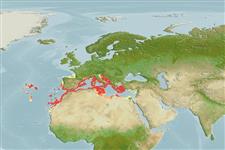Issue
Type species of genus
Environment: milieu / climate zone / depth range / distribution range
Ökologie
seewasser bathydemersal; tiefenbereich 30 - 569 m (Ref. 56504). Deep-water
Mediterranean Sea and subtropical Eastern Atlantic: Greece, Adriatic Sea, Tyrrhenian Sea, south Portugal and off Madeira (Ref. 4758, Ref. 13359). Also one specimen from 29°50.2'N, 28°29.8'W (Ref. 4758). Subtropical western Atlantic specimens may be this species (Ref. 34024).
Size / Gewicht / Alter
Maturity: Lm ? range ? - ? cm
Max length : 6.5 cm SL Männchen/unbestimmt; (Ref. 6526)
Rückenflossenstacheln (insgesamt) : 0; Rückenflossenweichstrahlen (insgesamt) : 81 - 96; Afterflossenstacheln: 0; Afterflossenweichstrahlen: 64 - 76. Mouth is large, with strong jaws; six caudal rays (Ref. 13359). Swim-bladder present; pelvic fins absent; several sharp spines present at lower angle of opercle; precaudal vertebrae 10 to 12; caudal fin broadly joined to dorsal and anal fins; male intromittent organ lacking ossified parts; females have genital pores (Ref. 34024).
Depth range from 30-500 m (Ref. 6526) and from 460-569 m in the eastern Ionian Sea (Ref. 56504). The food of Bellottia apoda appears to be a mixture of planktonic and benthic preys (Ref. 13359). Viviparous (Ref. 6526). Uncommon species (Ref. 34024), but it is not so rare as it seemed in the Adriatic Sea (Ref. 13359).
Nielsen, J.G., D.M. Cohen, D.F. Markle and C.R. Robins, 1999. Ophidiiform fishes of the world (Order Ophidiiformes). An annotated and illustrated catalogue of pearlfishes, cusk-eels, brotulas and other ophidiiform fishes known to date. FAO Fish. Synop. 125(18):178p. Rome: FAO. (Ref. 34024)
IUCN Rote Liste Status (Ref. 130435)
Bedrohung für Menschen
Harmless
Nutzung durch Menschen
Fischereien: nicht kommerziell
Tools
Zusatzinformationen
Download XML
Internet Quellen
Estimates based on models
Preferred temperature (Ref.
123201): 13.2 - 16.1, mean 14.6 °C (based on 142 cells).
Phylogenetic diversity index (Ref.
82804): PD
50 = 0.5312 [Uniqueness, from 0.5 = low to 2.0 = high].
Bayesian length-weight: a=0.01122 (0.00514 - 0.02450), b=3.04 (2.87 - 3.21), in cm total length, based on all LWR estimates for this body shape (Ref.
93245).
Trophic level (Ref.
69278): 3.4 ±0.50 se; based on food items.
Widerstandsfähigkeit (Ref.
120179): niedrig, Verdopplung der Population dauert 4,5 - 14 Jahre. (Fec=30-180).
Fishing Vulnerability (Ref.
59153): Low vulnerability (10 of 100).
Nutrients (Ref.
124155): Calcium = 68.1 [12.7, 259.9] mg/100g; Iron = 0.851 [0.294, 2.099] mg/100g; Protein = 16.3 [13.7, 18.7] %; Omega3 = 0.631 [0.223, 1.817] g/100g; Selenium = 8.69 [2.34, 30.20] μg/100g; VitaminA = 19.9 [4.1, 89.6] μg/100g; Zinc = 0.739 [0.370, 1.422] mg/100g (wet weight);
